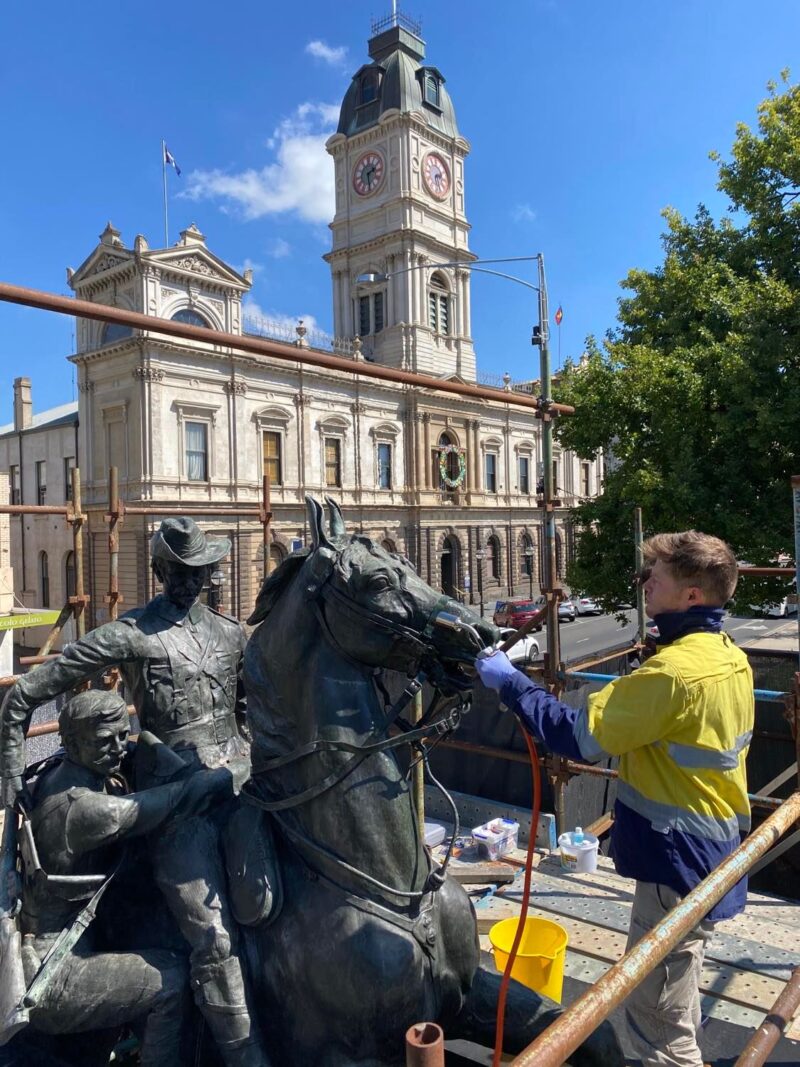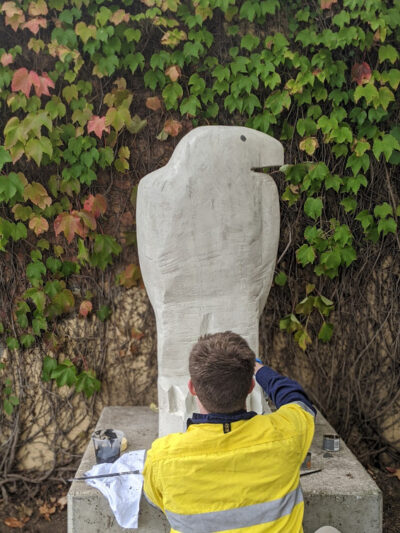Evan Tindal: objects conservator at Grimwade Conservation Services.

Evan Tindal working on an outdoor bronze sculpture.
How did you get started in conservation?
I started out working in archaeology. My first job out of university in the US was cleaning excavated artefacts for a cultural resources management company in Charleston, South Carolina, where I’m from. This is where I learned about conservation as a feasible profession outside of a fine arts context. My boss at this job was actually Emily Jateff, who is now a curator at the Australian National Maritime Museum, and she introduced me to the conservation team working on the Hunley submarine conservation project. One day a week volunteering there turned into a full-time internship, where I was exposed to parts of this profession I still love most: complexity in terms of scale and process, and being able to work with a large technology object. The project gave me some professional direction, so I started looking at options for further training.
So what brought you to Australia – originally, and then back again for your PhD?
The master’s course at the University of Melbourne offered something local programs didn’t: the opportunity to start straight away. My background in archaeology wasn’t completely compatible with the fine arts focus of local courses in the US (and admittedly my background was severely fine arts deficient, due to both lack of academic interest and opportunity). You can substitute some of the prerequisites with archaeology, but it would have put a longer timeframe on things, and at that point I was just ready to study. Australia offered what seemed more flexibility and opportunity for me at that time.
After completing the master’s in Melbourne, I was employed almost straight away back in the US in Florida, working for the Bureau of Archaeological Research. However, I always had in the back of my mind that I wanted to come back to Australia. I like the culture here generally and, working as the only conservator in my department, missed the conservation community in Australia. The chance to undertake a PhD with the Grimwade Centre came up in 2014, and I decided to take it. I had been considering further study back in America anyway, but funnily the move to Australia felt less foreign.
You say you didn’t have a lot of background in fine arts, but now work with it quite a bit in commercial practice. Can you speak to that learning experience?
I find that part of my illiteracy in fine arts can actually be beneficial. Not to say I’m preaching ignorance: I know a lot more now about how art is made from having conserved it, and enjoy learning about fabrication. However, I still don’t get much of a visceral or emotional response from art objects and, at this point, I don’t know if that will ever come! I actually find my lack of emotional response to artworks can be helpful in that I’m more objective about the materials, their conservation needs and the feasibility of treatment. Of course I take into account aesthetic and social significance, but the materiality of something is always at the forefront of my decision making. I also have found conversations with living artists to be critical in the conservation of their work: talking to the maker helps with understanding the way things are made and informs what exactly is significant about the object in order to conserve it. These conversations can, frankly, also be quite liberating: sometimes it’s ok to just sand and recoat something that’s been stored outside and where the original surface bears no resemblance to what the artist created.

Evan works on a painted and carved wooden sculpture, displayed outdoors.
Where do you see conservation being able to improve as a profession?
A lot of projects I work on require either new technologies or subcontracted labour from parallel industries like fabrication and construction. Being able to do this has improved the outcome of such projects immensely. Pushing conservation to be more of an interdisciplinary practice in general could, from my perspective, be extremely beneficial. This could be a two-way approach: educating trades in conservation principles, or incorporating different fabrication and restoration skills into the conservation training.